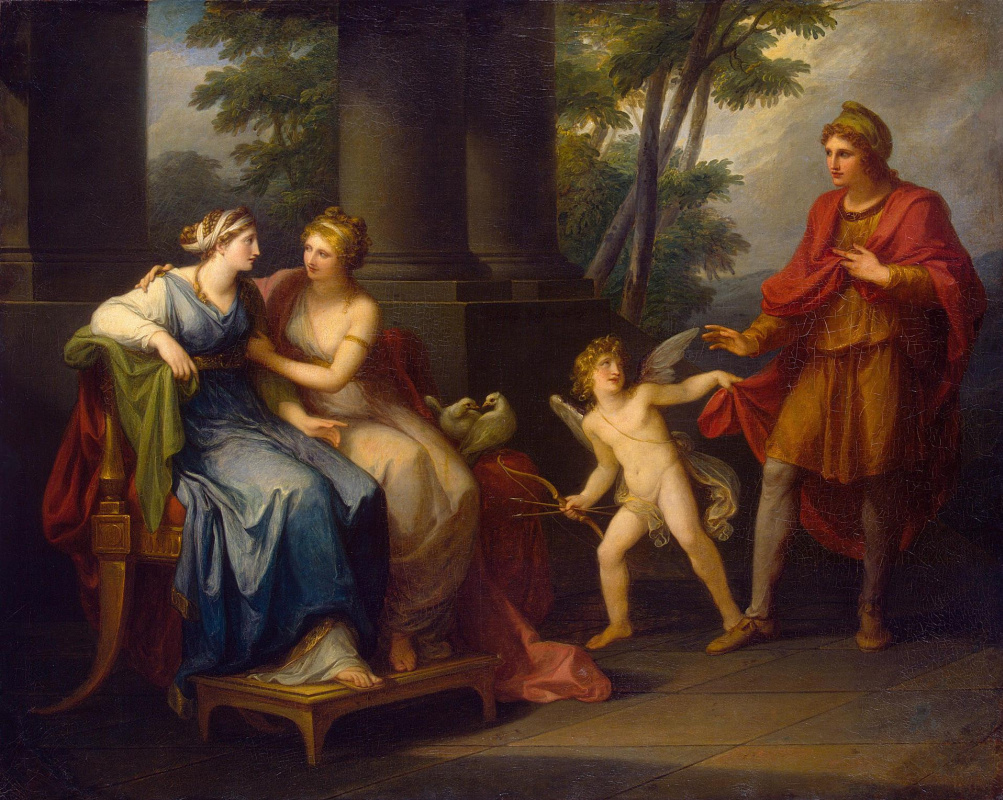log in
Enter site
Login to use Arthive functionality to the maximum
Venus persuading Helen to love Paris
Angelika Kaufman • 绘画, 1790, 127×102 厘米
画作描述 «Venus persuading Helen to love Paris»
"Venus persuading Helen to love Paris" one of eleven paintings by Angelica Kauffman in the collection of the Hermitage. The work was commissioned Kaufman Prince Nikolay Borisovich Yusupov, the largest Russian art collector and philanthropist, who acted as a mediator between the Empress Catherine II and Emperor Paul I and European artists. Yusupov ran the Armory, and in 1797-m even briefly headed the Hermitage. Thus, the personal collection of the Prince was enriched from the same sources that the best museums of Russia. In order journal Kaufman in October 1785 recorded that Yusupov paired with the painting "Venus persuading Helen to love Paris" ordered another canvas of the same size, depicting the dying of Ovid on the coast of Pontus (the Roman poet died in exile on the Black sea). The last picture, apparently not preserved, and "Venus..." was first at St. Petersburg palaces Yusopova on the Fontanka and Moika, already in Soviet times, was transferred to the Hermitage.
The first being in Rome at the age of thirteen, Michelangelo vividly perceived and internalized the complex plots and motifs of Greco-Roman mythology and, in line with the emerging neo-classical, wrote a lot on ancient themes. The story of the paintings "Venus persuading Helen to love Paris," the artist borrows from the 3rd song of Homer's "Iliad". In the dispute between the goddesses Hera, Athena and Aphrodite about who is the most beautiful, Paris gave the superiority of Aphrodite (in Roman mythology Venus). As a reward, Venus promised him the love of the most beautiful of all mortal women. The painting depicts Kaufman as Venus with Cupid tips the Helen of Troy, not inferior in the beauty of the goddess, to love Paris. Gentle eyes of Venus captivates Elena, and the baby Cupid like rushing indecisive Paris.
Painting executed in an academic manner (smooth colourful surface of the canvas; the classic shape and posture, loosely copied Kaufman with antique reliefs), and contains several symbolic moments. Cooing doves, intertwined tree trunks, pair of Cupid's arrows and ancient columns are designed to emphasize that the idea of Venus will sooner or later be crowned with success.
Author: Anna Yesterday
The first being in Rome at the age of thirteen, Michelangelo vividly perceived and internalized the complex plots and motifs of Greco-Roman mythology and, in line with the emerging neo-classical, wrote a lot on ancient themes. The story of the paintings "Venus persuading Helen to love Paris," the artist borrows from the 3rd song of Homer's "Iliad". In the dispute between the goddesses Hera, Athena and Aphrodite about who is the most beautiful, Paris gave the superiority of Aphrodite (in Roman mythology Venus). As a reward, Venus promised him the love of the most beautiful of all mortal women. The painting depicts Kaufman as Venus with Cupid tips the Helen of Troy, not inferior in the beauty of the goddess, to love Paris. Gentle eyes of Venus captivates Elena, and the baby Cupid like rushing indecisive Paris.
Painting executed in an academic manner (smooth colourful surface of the canvas; the classic shape and posture, loosely copied Kaufman with antique reliefs), and contains several symbolic moments. Cooing doves, intertwined tree trunks, pair of Cupid's arrows and ancient columns are designed to emphasize that the idea of Venus will sooner or later be crowned with success.
Author: Anna Yesterday


